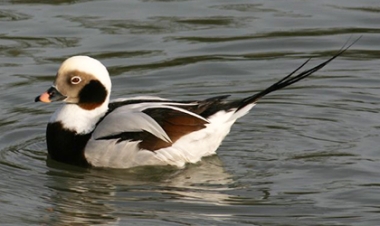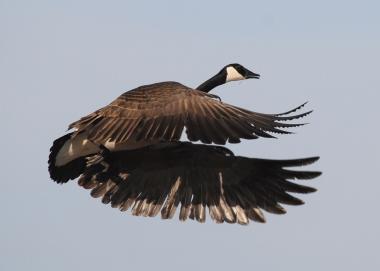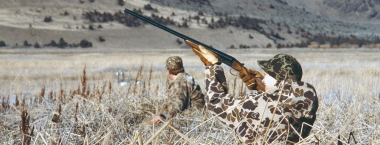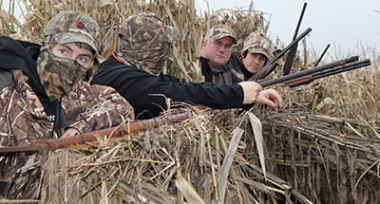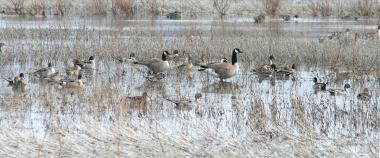

2018 Eastern Oregon waterfowl forecast
What to expect when waterfowl hunting this year in the eastern part of the state.
Contents
Statewide outlook
Eastern Oregon upland game bird forecast
Eastern Oregon waterfowl forecast
Western Oregon upland game bird forecast
Western Oregon waterfowl forecast
Baker County
Duck and goose hunting is expected to be similar to past years with a few resident birds available early in the season. More migrant birds will arrive later in the season and hunting should improve, especially in the Baker and Keating valleys. Almost all hunting is on private property, so be sure to ask permission before hunting. The Powder River from Baker City to Brownlee Reservoir offers the best waterfowl hunting.
Deschutes County
Duck and geese hunting should be average or above average for local birds prior to freeze up. Canada geese numbers have increased over past survey years. Due to low water levels, some areas may be high and dry for hunting season and access to waterfowl will be difficult in some areas. Hunters hunting the upper Deschutes River area are reminded of the Deschutes County Ordinance where portions of the river between Sunriver and Fall River are closed to the discharge of firearms (reference the Deschutes County Sheriff’s office website for more information).
Crook and Jefferson counties
Mallards and Canada geese are the most common waterfowl species in these counties. Hunting opportunities are limited due to the lack of wetlands, marshes, and access, especially on public lands. Most of the better hunting is associated with private agricultural lands where gaining access can be difficult.
Grant County
Grant County offers very limited waterfowl hunting opportunities due to lack of habitat; it’s mostly jump shooting on private land along the John Day River.
Harney County
Typically hunting is best in late fall and early winter and on agricultural lands. Be sure to get landowner permission before hunting private lands. Portions of Malheur National Wildlife Area are open to waterfowl hunting (see the Game Bird Hunting Regulations) though hunting success and access to hunting areas is dependent on water levels in Malheur Lake. Lake levels this year are low enough that access will be difficult and hunting success will likely be poor.
Klamath County
Early season usually is best for local and early migrant ducks. Hunting prospects will depend on Pacific Northwest weather systems moving birds into and around Klamath County before freeze-up.
Most goose hunting opportunities are for resident Canada geese, however there are some white-fronted, snow and Ross’s geese staging in the Klamath Basin prior to continuing south. Goose hunting should improve later into the season with freezing conditions, which tend to concentrate geese near open water areas. Ample public land opportunities exist with area refuges and state managed wildlife areas in addition to private lands.
The late goose season (Jan. 16-March 10, 2019) will again be open all areas with the exception of Klamath Basin Refuges and Miller Island Unit at Klamath Wildlife Area. The hunt helps alleviate agricultural damage from large numbers of white-fronted, lesser snow and Ross’ geese.
Contact ODFW's Klamath Falls office at (541) 883-5732 for more information.
Klamath Wildlife Area – Miller Island Unit
The Miller Island Unit is open to hunting and public use daily through the end of September, except on the days reserved for youth waterfowl and upland hunts (September 15, 16, 22, 23). Hunters should expect good hunting for mourning doves early in the season and Canada geese can be found during the September Canada Goose season.
Opening weekend for general waterfowl and pheasant hunting seasons is Oct. 6 (reservation only) and Oct. 7. Hunt days are then every following Monday, Wednesday and Saturday from October-December and open every day in January during authorized gamebird seasons. Upland bird hunting opens at 10 a.m. during waterfowl season (see regulations for details).
A daily hunting permit is required and hunters shall be in possession of permit while in the field. Check out is required. Daily hunt permits are available at the check station located on the North side of Miller Island Rd. just west of the railroad tracks.
Early season is usually best for local and early migrant birds, and hunters can expect to find abundant gadwalls and mallards on the wildlife area.
Goose hunting should improve later in the season with geese using frozen ponds for loafing and the small grain fields for forage.
Pheasants are released throughout the season thanks to donations by Unlimited Pheasants. After Oct. 12, pheasants will be released in subunits A and C.
Management programs on the Klamath WA-Miller Island Unit could impact waterfowl hunter access during the 2018-19 waterfowl seasons. Efforts to rehabilitate portions of the marshlands around the Miller Island Unit, which will improve habitat for a multitude of waterfowl species, will require dewatering certain wetlands and actively controlling overgrown vegetation. Area managers will try to bring water back to all areas as soon as possible, but some portions of the unit may be dry or at low water levels and will not provide good hunting opportunities throughout the early season. These rehabilitated marshes will provide important food sources for birds in coming years and will greatly benefit hunters in the long term.
There is a special youth waterfowl and upland bird hunt on October 20 when the unit is open only to hunters age 17 and younger. Hunters must be accompanied by an adult 21 years or older, who may not hunt. Reservations are not required for this hunt. See page 26 of the Oregon Game Bird Regulations.
Lake County
Summer Lake Wildlife Area
Over 60 percent of this almost 19,000-acre area is open for game bird hunting during authorized seasons. Hunting is permitted 7 days per week and a free daily hunting permit is required. Hunting permits are available at Headquarters. Hunters should be aware the wildlife area is not open during the September Canada goose season.
In most years, a fair number of mourning doves can be found early in September but they typically move south once cooler fall weather conditions arrive. The best areas to hunt on the wildlife area are from Thousand Spring Lane (Lake Co. Road 4-17) north toward Lake View Lane (4-18) and old homestead sites such as the Turner Place.
Waterfowl hunting conditions should be good across most of the wildlife area. Water supplies have been fairly good, but some areas may be slow to flood-up due to growing season management actions. Gold Dike Impoundment and the area South of Gold Dike was held at a low level most of the growing season so submerged aquatic plants may not be as extensive as in the past. However, moist-soil annual plants should produce abundant seed sources in many areas. Summer Lake proper has held a good level most of the summer, but the recent drying trend has seen its size decline dramatically.
The early portion of the waterfowl season is usually best for local and early migrant birds, and hunters can expect to find abundant dabbling ducks such as green-winged teal, gadwall, shoveler, wigeon, pintail and mallards on the wildlife area. Waterfowl production was fairly strong this year, with good numbers of Canada goose, gadwall, mallard and cinnamon teal broods being observed throughout summer. Regular season goose hunting should be fair for locally produced Canada geese. Canada goose hunting should improve later in the season with freezing conditions, which tend to concentrate geese near open water. In an attempt to reduce harvest pressure on the rarer Tule white-fronted goose, the daily bag limit is one.
Most snow geese staging at Summer Lake Wildlife Area are from Wrangel Island, Russia. Production this year is predicted to be down from last year, but the population has been on a recent upward trend. Typically, good production results in favorable hunting success due to the large number of juveniles. When production is low, hunting for the more wary adults is difficult. A large portion of this population is either wintering in NW Washington/SW British Columbia or staying on northern (Alberta) staging grounds until late in the fall, until they are pushed south by winter weather. Unfortunately, these geese migrating out of Canada are now by bypassing traditional staging areas such as Summer Lake on their way to California. Recently, staging numbers at the wildlife area appear to have stabilized at around 5-6,000 birds. Favorable weather conditions will be necessary to encourage large numbers of geese to stage in the basin, reduce overflights to wintering areas further south, and create favorable hunting conditions.
Closure: Access to hunting areas south of Thousand Springs Lane (Lake Co. Rd 4-17, except the Foster Place) will be prohibited from Sept. 29 until 4:00 am on opening day (Oct. 6). This seven-day closure will reduce disturbance to staging waterfowl and improve hunter success. Campgrounds and open roads will remain available for use.
Malheur County
Many of the desert ponds dried up this summer because of mild winter conditions and very little precipitation, but those ponds that held water through the summer had fair duck and goose production. Desert ponds are also a good opportunity for early season jump shooting. Jordan Valley provides an excellent opportunity for September Canada goose hunting. Hunters need to get permission to hunt private lands.
Fair waterfowl hunting is available in the Treasure Valley (agricultural areas near the Snake River in the vicinity of Ontario, Adrian and Nyssa) most of the season, and improves significantly during cold weather events. Cold weather events reduce open water, concentrating birds and increasing the time spent foraging. Field hunting for both geese and ducks can be good for hunters willing to spend the time and effort to secure access to private land.
Mid-Columbia District (Wasco, Sherman and Hood Counties)
Duck hunting is mostly jump shooting on private lands and should offer good opportunity where available. Goose hunting opportunity in wheat fields should be good with most access via private land. Some private land access can be found through Upland Cooperative Access Program lands in Sherman County.
The Columbia River is open for hunting and provides some opportunities for hunters up to Arlington. Access will primarily be by boat. For more information contact ODFW The Dalles at 541-296-4628. Note that hunting is not allowed on most Corps of Engineers property.
Umatilla and Morrow counties
Hunting prospects depend on weather conditions. If the region does not experience a real winter, many of the northern migrants will stay in Washington. The best hunting is usually later in the season (late November) after some weather pushes birds down northern areas. The Columbia River is usually the best opportunity for hunters on public land, but those who can access irrigated circles in northern Morrow County usually get good goose hunting.
Habitat in the Columbia Basin still supports large numbers of wintering Canada geese and the number of snow geese wintering in this area has greatly increased in recent years. Waterfowl hunters should not forget about the Columbia Basin Wildlife Areas (Power City, Irrigon, Coyote Springs, Willow Creek). Food crops were planted and ponds have been enhanced, all of which will make conditions better for waterfowl hunting.
Union County
Duck and goose hunting is expected to be similar to last year.
Ladd Marsh Wildlife Area
The 2018 year was another good production year for waterfowl especially Canada geese. Nest success appears to be similar to past years with many observations of mallard, gadwall and teal broods. Water levels in the marsh are currently low but most wetlands still have a small amount of huntable water. Hunters should call the office at 541 963 4954 to get a current update on water levels and locations so you don’t waste a trip. Fall precipitation will improve hunting conditions and access as the waterfowl season progresses. Key in on newly flooded areas as these locations will provide good forage for waterfowl.
All visitors including hunters must have in their possession a free daily permit to access the wildlife area. Permits are available at several self-check-in stations at entry points and parking lots. The Wildlife Area is closed 10 p.m. - 4 a.m. daily. There is no camping on the wildlife area. Both of these rules include area parking lots. Violators will be asked to leave and may be cited.
Wallowa County
Waterfowl hunting should be similar to previous few years. Expect good hunting opportunities later in the fall and early winter when migrating birds arrive. The few resident geese Canada geese in the district have fared well, too. Most hunting is decoy hunting in agricultural fields, and jump shooting irrigation ditches so be sure to get landowner permission before hunting.
Waterfowl hunting locations
Explore bird hunting locations using ODFW’s Oregon Hunting Access Map. ODFW's Summer Lake and Klamath wildlife areas are major winter staging areas for waterfowl and provide great hunting opportunities. Ladd Marsh Wildlife Area provides opportunities in northeast Oregon. Some private lands are accessible through the Access and Habitat program. Remember to ask permission before hunting on private lands.

